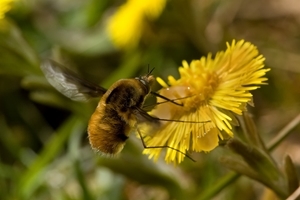Dark-edged bee-fly
“If I was to describe it compared to other animals it was a cross between a bee, a golden mole and a narwhal – but that sounds really silly.” – Anon
 Around this time every year, apparently the Natural History Museum enquiry inbox is full of puzzled gardeners asking what on earth is buzzing round their flowers, saying that it isn’t a bee, and it isn’t a fly, so what is it? Well, they’ve more or less answered their own question: it’s the bee-fly! These flies are so-called because of their physical mimicry of bees, and the sinister manner of their life-cycle association with solitary bees.
Around this time every year, apparently the Natural History Museum enquiry inbox is full of puzzled gardeners asking what on earth is buzzing round their flowers, saying that it isn’t a bee, and it isn’t a fly, so what is it? Well, they’ve more or less answered their own question: it’s the bee-fly! These flies are so-called because of their physical mimicry of bees, and the sinister manner of their life-cycle association with solitary bees.
Before we look more at the bee-fly, some clarification. If you are confused about whether what you’re looking at is a bee or a fly, here are a few easy ways to tell. Firstly, flies have one pair of wings, and bees have two. The vast majority of bees are ‘busy’, rarely landing on surfaces other than flowers or nest sites, whereas flies will land on any surface and quite often appear to rub their ‘hands’. Lastly, flies have big, forward-facing googly eyes, whereas bees’ are usually thinner and wider apart.
The most common bee-fly in Britain is the dark-edged bee-fly (Bombylius major), which is often encountered in gardens and also likes open deciduous woodland. It is a spring-flying species found across temperate Eurasia and North America, seen from late March to the end of May.
In flight it looks like a hairy ginger bee and it flies with a blur of wings and in noticeable ‘planes’ of flight like a helicopter. The most striking feature of bee-flies is a long, non-retractable proboscis, which is essentially a tubular tongue (comedy award goes to the person whose Natural History Museum help enquiry read “I think it was a hornet because it had a horn?”). When at rest, it holds its wings out at a wide angle. This species is easily distinguished from its fellow Bombylius bee-flies by the dark-brown front edge of each wing, for which it is named.
The dark-edged bee-fly can be spotted visiting a range of spring flowers such as coltsfoot, ground-ivy, primroses, lungwort, garden spurges and bugle. They hover above the flower, cling on with their delicate legs and stick in their proboscis to drink nectar. When they are not foraging, they rest on leaves, bark, garden objects and sometimes bare ground. If you see one scouting over the ground, there’s a good chance it’s a mated female looking for the nests of solitary mining bees.
She uses her physical mimicry to gain close access to the nests, because her strategy is to lay eggs in the bee nest, which will then hatch into larvae and eat the young bee grubs. First, she dips her abdomen on the ground to coat her eggs with dust and grit, which adds weight and camouflage to them. Then, she opens fire, flicking the eggs one by one into bee nesting burrows. Recently I saw an amazing video of a female doing this near a nest of the solitary bee (Andrena vaga). You know the ‘kwa-tsch’ action of a whip – imagine this bee doing it with its ovipositor and that’s what it looks like. I’d like to think it sounds like that too.
If you have a nice sunny bank in the garden or patches of lawn frequented by mining bees, it might be interesting to sit and watch for bee-flies, and perhaps you’ll see the egg-slinging in action. Remember, just look for a furry ginger bee that isn’t a bee, with a narwhal horn, flying like a helicopter.
Jess Brooks
Advisory
Photo credit: Richard Bartz